Nucor Bundle
How Did Nucor Revolutionize the Steel Industry?
From nuclear instruments to the pinnacle of American steel manufacturing, Nucor's story is one of remarkable transformation. This journey showcases how strategic innovation can reshape an entire industry. Discover how a company, born from the ashes of a different era, rose to become North America's largest steel producer.
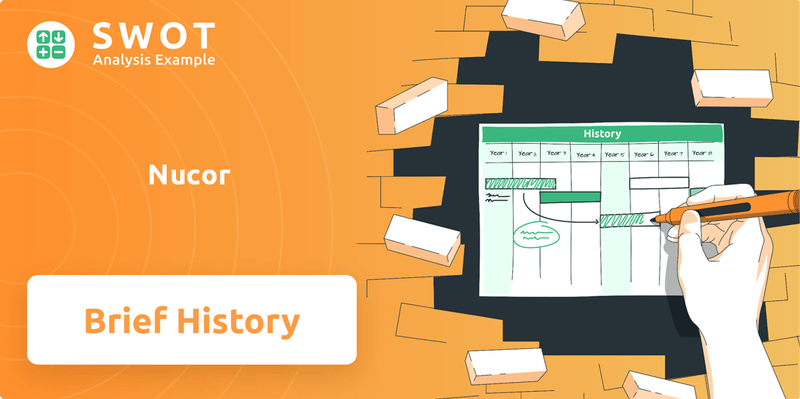
The Nucor SWOT Analysis reveals how Nucor's early adoption of electric arc furnace (EAF) mini-mills in the late 1960s was a game-changer, enabling more efficient steel production. This pivotal shift allowed Nucor to capitalize on scrap metal, fundamentally altering the landscape of the American steel industry. Understanding the brief history of Nucor Company provides crucial insights into its present-day success and its ongoing impact on the steel market.
What is the Nucor Founding Story?
The story of Nucor, a leading force in the American steel industry, began not with steel, but with automobiles. Its roots trace back to Ransom E. Olds' REO Motor Car Company, established in 1905. This early venture laid the groundwork for what would eventually become the Nucor we know today, undergoing a significant transformation over several decades.
The transition towards steel production began in the mid-1960s, marking a pivotal shift for the company. This period saw strategic acquisitions and leadership changes that would shape Nucor's future. The acquisition of Vulcraft in 1962, a producer of steel joists and girders, was a key move that set the stage for its steel manufacturing focus.
By 1965, facing financial challenges, Nuclear Corporation appointed F. Kenneth Iverson as president and Samuel Siegel as CFO. This leadership team would be instrumental in steering the company toward profitability and establishing its innovative approach to steelmaking.
Nucor's early years were marked by strategic decisions and a focus on efficiency.
- In 1962, Nuclear Corporation acquired Vulcraft.
- F. Kenneth Iverson became president in 1965.
- The first mini-mill opened in 1969.
- The company officially adopted the name 'Nucor' in 1972.
Iverson and Siegel quickly reorganized the company, concentrating on Vulcraft, the only profitable division at the time. They sold off underperforming parts of the business to streamline operations. A key challenge was the high cost of steel. Iverson recognized that producing its own steel would be more cost-effective, leading to a revolutionary decision: investing in electric arc furnace (EAF) mini-mills.
These mini-mills could produce steel more efficiently and at lower costs using scrap metal. The first mini-mill opened in Darlington, South Carolina, in 1969, to supply steel to the Vulcraft divisions. This move was a significant departure from traditional steelmaking methods, marking the beginning of Nucor's innovative approach.
Nucor's steel venture emerged from a period of near bankruptcy. To build its first steel bar mill, the company secured a $6 million loan. The name 'Nucor' was officially adopted in 1972, symbolizing its complete shift to steel manufacturing. In 1966, the company's headquarters moved from Phoenix, Arizona, to Charlotte, North Carolina, to be closer to its main Vulcraft plant. This period also saw the introduction of a performance-based profit-sharing program, a key element of Nucor's culture.
Nucor SWOT Analysis
- Complete SWOT Breakdown
- Fully Customizable
- Editable in Excel & Word
- Professional Formatting
- Investor-Ready Format
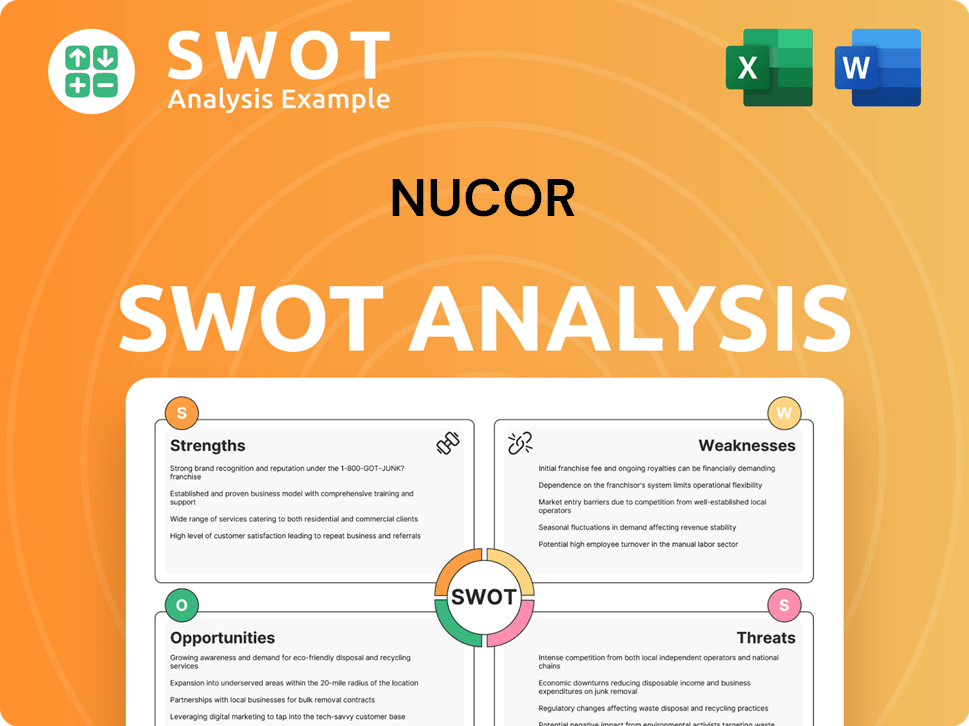
What Drove the Early Growth of Nucor?
The early growth and expansion of the Nucor history was significantly shaped by its adoption of electric arc furnace (EAF) mini-mill technology. This innovative approach revolutionized steel manufacturing, allowing for more efficient and cost-effective production. Nucor's strategic investments in EAFs and its expansion into new steel products were key to its early success.
Nucor's initial mini-mill, opened in Darlington, South Carolina, in 1969, was a pivotal moment for the Nucor company. This mill used scrap metal as its primary input, setting a new standard for the American steel industry. This innovation allowed Nucor to produce steel more efficiently than traditional integrated mills.
During the 1970s, Nucor continued to invest in EAF technology, establishing additional steel mills across the U.S. This expansion was a direct response to the growing demand and the cost advantages offered by the mini-mill model. This strategic move positioned Nucor favorably within the evolving steel industry.
A significant milestone was the launch of the world's first EAF sheet mill in Crawfordsville, Indiana, in 1989. This demonstrated the capability of EAFs to produce high-quality, flat-rolled sheet steel. By 2024, Nucor's total assets were approximately $33.9 billion, reflecting its substantial growth and impact on the market.
Throughout the 1980s, Nucor expanded into new steel products, including sheet steel and structural steel beams. Strategic acquisitions, such as Vulcraft in 1962, supported its growth. Nucor's decentralized management structure fostered innovation and contributed to its operational efficiency.
Nucor PESTLE Analysis
- Covers All 6 PESTLE Categories
- No Research Needed – Save Hours of Work
- Built by Experts, Trusted by Consultants
- Instant Download, Ready to Use
- 100% Editable, Fully Customizable
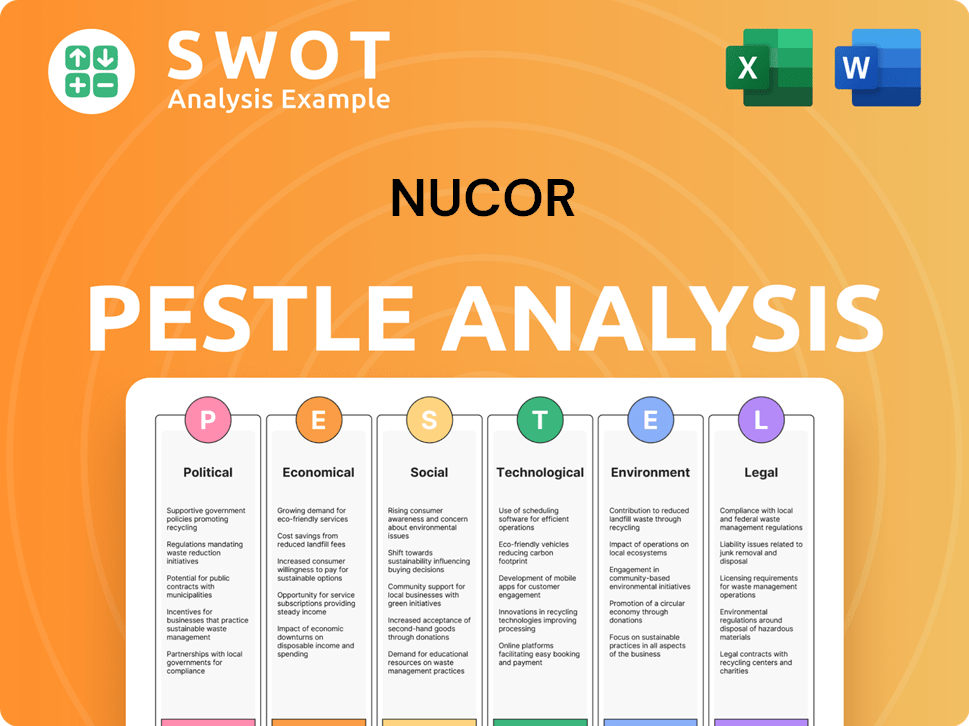
What are the key Milestones in Nucor history?
The Nucor history is marked by significant milestones that have shaped its trajectory in the steel industry. From its founding to becoming a leading American steel producer, the company's journey is a testament to strategic innovation and resilience.
| Year | Milestone |
|---|---|
| 1969 | Nucor began using electric arc furnace (EAF) mini-mills at its plant in Darlington, South Carolina, revolutionizing steel manufacturing. |
| 1989 | Nucor launched the world's first EAF sheet mill in Crawfordsville, Indiana, expanding the capabilities of mini-mills. |
| 2021 | Nucor launched Econiq, the world's first net-zero carbon steel at scale, showcasing its commitment to sustainability. |
| 2023 | Nucor entered a carbon capture and storage (CCS) agreement with ExxonMobil to reduce carbon emissions from its Louisiana plant. |
The Nucor company has consistently embraced innovation to stay ahead in the competitive steel industry. A key innovation was the adoption of EAF mini-mills, which allowed for more efficient and cost-effective steel production. This approach, coupled with a focus on sustainability, has positioned Nucor as a leader in low-carbon steel production.
Nucor pioneered the use of EAF mini-mills, which use scrap metal to produce steel, making the process more efficient and cost-effective. This innovation significantly reduced production costs compared to traditional steelmaking methods.
Nucor's launch of the first EAF sheet mill demonstrated that mini-mills could produce high-quality, flat-rolled sheet steel. This expanded the range of products mini-mills could produce, challenging the established steelmaking methods.
Nucor introduced Econiq, the world's first net-zero carbon steel at scale, showcasing its commitment to sustainable practices. This initiative aimed to reduce the environmental impact of steel production.
Nucor's partnership with ExxonMobil for carbon capture and storage aimed to remove up to 800,000 metric tons of CO2 per year from its Louisiana plant. This initiative will further reduce carbon emissions.
Nucor is North America's largest recycler and a global leader in low-carbon steel production. This focus on sustainability helps reduce the environmental impact of steel production.
Nucor places a strong emphasis on employee safety, which has contributed to a safer working environment. This commitment has helped to improve operational efficiency and employee morale.
Despite its successes, Nucor steel has faced several challenges, including market fluctuations and competitive pressures. The steel industry is cyclical, and Nucor's financial performance can vary. However, the company's strategic approach and strong financial position help it navigate these challenges.
Nucor has experienced fluctuations in financial performance, with net earnings decreasing in 2024 compared to 2023. The steel industry is cyclical, and Nucor's results are affected by market conditions.
The steel industry is highly competitive, requiring Nucor to continuously innovate and adapt. Nucor faces competition from both domestic and international steel producers.
In Q1 2025, Nucor's net earnings were down compared to Q1 2024, partly due to lower selling prices. This highlights the volatility inherent in the steel market.
Reduced margins in raw materials also contributed to the decline in earnings. Fluctuations in raw material costs can impact profitability.
Nucor's operating rates at its steel mills were at 80% in Q1 2025, indicating efficient production. This shows Nucor's ability to maintain high operational efficiency.
For the full year 2024, Nucor reported net earnings of $2.03 billion, a decrease from $4.53 billion in 2023. Consolidated net sales for 2024 were $30.73 billion, an 11% decrease from $34.71 billion in 2023.
For more insights into Nucor's strategies, consider reading about the Growth Strategy of Nucor.
Nucor Business Model Canvas
- Complete 9-Block Business Model Canvas
- Effortlessly Communicate Your Business Strategy
- Investor-Ready BMC Format
- 100% Editable and Customizable
- Clear and Structured Layout
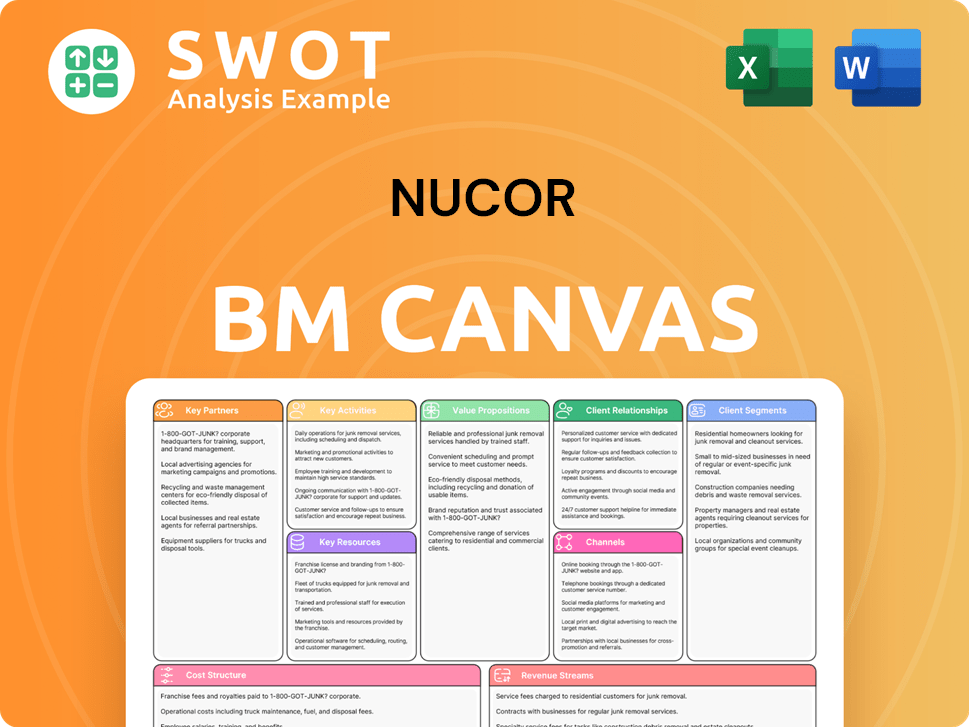
What is the Timeline of Key Events for Nucor?
The Nucor history is a story of innovation and strategic growth within the steel industry. From its origins as REO Motor Car Company to its current standing as a leading American steel producer, Nucor company has consistently adapted and expanded its operations. This journey is marked by significant milestones that have shaped its trajectory and solidified its position in the market.
| Year | Key Event |
|---|---|
| 1905 | Ransom E. Olds forms REO Motor Car Company, which later becomes a predecessor to Nucor. |
| 1955 | REO Motor Car Company is renamed Nuclear Corporation of America. |
| 1962 | Nuclear Corporation acquires Vulcraft and hires Ken Iverson, a pivotal figure in Nucor's history. |
| 1965 | Ken Iverson becomes president, steering the company through financial challenges. |
| 1966 | The company headquarters relocates to Charlotte, North Carolina. |
| 1969 | The first mini-mill opens in Darlington, South Carolina, utilizing Electric Arc Furnace (EAF) technology. |
| 1972 | The company officially adopts the name Nucor Corporation. |
| 1989 | Nucor launches the world's first EAF sheet mill in Crawfordsville, Indiana, a major innovation in steel manufacturing. |
| 2007 | Nucor acquires David J. Joseph (DJJ), a significant scrap metal processor. |
| 2021 | Nucor launches Econiq, the world's first net-zero carbon steel at scale, demonstrating its commitment to sustainable production. |
| 2023 | Enters a carbon capture and storage agreement with ExxonMobil. |
| 2024 | Reports full-year net sales of $30.73 billion and net earnings of $2.03 billion. |
| 2025 (Q1) | Reports net sales of $7.83 billion and net earnings of $156 million. |
| 2025 (May) | Nucor adjusts its hot-rolled coil (HRC) steel price, indicating market shifts. |
Nucor is focused on maintaining its leadership in the North American steel industry and expanding its market presence. The company’s investment strategy continues to position it as a premier North American steel producer, aiming to create long-term economic value for customers and shareholders.
Nucor is pursuing opportunities in carbon-free energy options for its operations and growth projects. Pre-operating and start-up costs for growth projects were approximately $170 million in the first quarter of 2025, showing its commitment to sustainable practices.
Analysts anticipate Nucor's EPS to rebound in 2026, growing by 36.9% year-over-year to $10.87, after an expected decrease to $7.94 per share in fiscal 2025. The company's revolving credit facility was amended in March 2025, increasing its borrowing capacity to $2.25 billion and extending its maturity to March 11, 2030, remaining undrawn.
Nucor's CEO, Leon Topalian, has stated that while steel demand softened in 2024, market conditions are improving and should gain momentum into 2025. He emphasizes that the U.S. economy is on the front end of several steel-intensive megatrends, and Nucor is well-positioned to meet those needs as America's largest and most diversified steel producer.
Nucor Porter's Five Forces Analysis
- Covers All 5 Competitive Forces in Detail
- Structured for Consultants, Students, and Founders
- 100% Editable in Microsoft Word & Excel
- Instant Digital Download – Use Immediately
- Compatible with Mac & PC – Fully Unlocked
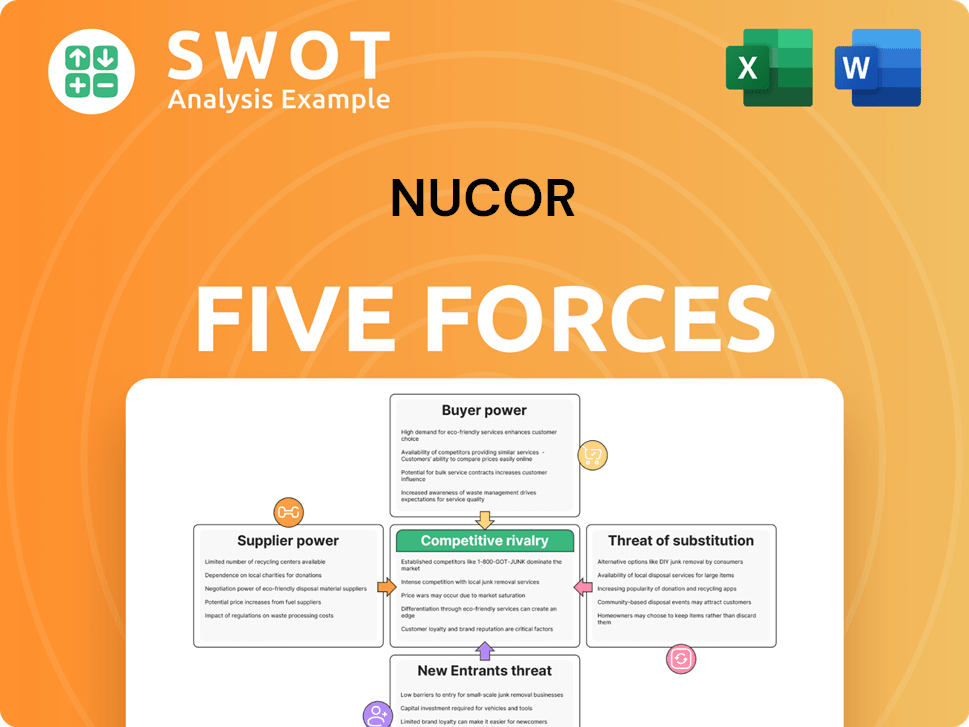
Related Blogs
- What is Competitive Landscape of Nucor Company?
- What is Growth Strategy and Future Prospects of Nucor Company?
- How Does Nucor Company Work?
- What is Sales and Marketing Strategy of Nucor Company?
- What is Brief History of Nucor Company?
- Who Owns Nucor Company?
- What is Customer Demographics and Target Market of Nucor Company?
Disclaimer
All information, articles, and product details provided on this website are for general informational and educational purposes only. We do not claim any ownership over, nor do we intend to infringe upon, any trademarks, copyrights, logos, brand names, or other intellectual property mentioned or depicted on this site. Such intellectual property remains the property of its respective owners, and any references here are made solely for identification or informational purposes, without implying any affiliation, endorsement, or partnership.
We make no representations or warranties, express or implied, regarding the accuracy, completeness, or suitability of any content or products presented. Nothing on this website should be construed as legal, tax, investment, financial, medical, or other professional advice. In addition, no part of this site—including articles or product references—constitutes a solicitation, recommendation, endorsement, advertisement, or offer to buy or sell any securities, franchises, or other financial instruments, particularly in jurisdictions where such activity would be unlawful.
All content is of a general nature and may not address the specific circumstances of any individual or entity. It is not a substitute for professional advice or services. Any actions you take based on the information provided here are strictly at your own risk. You accept full responsibility for any decisions or outcomes arising from your use of this website and agree to release us from any liability in connection with your use of, or reliance upon, the content or products found herein.